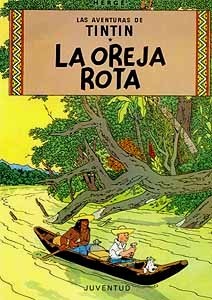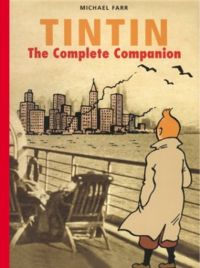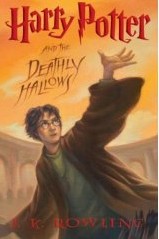English titles of Tintin books, by year first published (in French) in Belgium:
- 1930: Tintin in the Land of the Soviets.
- 1931: Tintin in the Congo.
- 1932: Tintin in America.
Tintin travels to the New World and faces Al Capone.
Snowy saves Tintin almost as often as Tintin saves Snowy while they
clean up the gangsters of Chicago and try to help the Blackfoot Nation.
Hergé's drawings based on his photo archive
include:
aeroplanes,
an ambulance,
cactus,
cars,
a dungeon,
horses,
lorries,
motorbikes,
a motor boat,
an ocean liner,
a skyscraper (on whose wall Tintin walks, from one window to another),
a suit of armor,
a tiger,
trains,
and
a wagon.
- 1934: Cigars of the Pharaoh.
Tintin travels to Egypt and meets
the eccentric Professor Sophocles Sarcophagus
and then the hilarious detective twins,
Thompson and Thomson, who both hinder and save Tintin.
The story concerns Tintin's foiling of drug runners.
The setting morphs from Egypt to India, apparently
with nonchalant ease.
Hergé's drawings based on his photo archive
include:
aeroplanes,
ambulances,
ancient Egyptian tomb,
armaments (machine guns, rifles, automatic weapons, handguns),
boats,
cars,
donkeys,
elephants,
ocean liner,
palace,
trains.
- 1936: The Blue Lotus.
The story concerns Tintin's foiling of drug runners.
Historical note in the English-language version includes:
|
The story is set in 1931.
At that time Japanese troops were occupying parts of the Chinese mainland,
and Shanghai, the great seaport at the mouth of the Yangtze Kiang,
possessed an International Settlement, a trading base in China for Western nations,
administered by the British and the Americans.
Hergé based his narrative freely upon the events of the time,
including the blowing-up of the South Manchurian railway,
which led to further incursions by
Japan into China and ultimately to Japan's resignation from the League of Nations in 1933.
|
The story begins in India, continuing from the end of
(Cigars of the Pharaoh)
and then moves to China.
Tintin mostly escapes from capture, imprisonment, swords, and guns through his own creativity,
but towards the end is helped by the Chinese boy Chang Chong-chen,
his new best friend, whom Tintin saves from drowning in a yellow river.
Thomson and Thompson arrive in bold disguise to arrest Tintin
and to demonstrate their increased self-inflicted damage by tripping
over their own feet.
Hergé's drawings based on his photo archive
include:
aeroplanes,
ambulance,
bicycle,
boats,
cars,
horse,
jinricksha,
lorries,
motorbikes,
ocean liners,
palace,
tanks,
trains.
- 1937: The Broken Ear.
Tintin tracks a stolen museum statuette to the Republic of San Theodoros, South America.
Drawings include aeroplanes, cars, trains,
armaments,
a tractor,
ocean liners, motor launch, and working boats.
- 1938: The Black Island.
Considered Hergé's first masterpiece.
A delight.
Tintin
(aided and hindered by Thomson and Thompson)
tracks a crashed unregistered plane to southern England,
escapes from being thrown off the White Cliffs of Dover,
and though a series of skin-of-teeth escapes,
reaches Scotland's Black Isle and uncovers the International Gang.
Drawings include:
aeroplanes, cars, trains,
armaments,
a fire-engine,
a castle, and pubs.
Tintin: The Complete Companion
comments that Hergé's original drawings lacked
characteristics of the English and Scottish
scenery, buildings, vehicles, and uniforms;
and reports that before the production
of the English-language books,
Hergé sent an artist to Britain
in order to bring back realistic images
for copying into the cartoon backgrounds.
- 1939: King Ottokar's Sceptre.
Tintin
(aided and hindered by Thomson and Thompson)
tracks mysterious mustachioed men to the central-European country of
Syldavia and averts trouble.
Drawings include:
aeroplanes, cars,
motorbikes,
a castle,
a royal coach,
the dinosaur Diplodocus Giganticus,
and
a birch forest.
- 1941: The Crab with the Golden Claws.
Tintin
(hindered by the ill-disguised and accident-magnetic Thomson and Thompson
with their "to be precise" repetitions
of what the other one says)
tracks drug-runners
and meets the alcoholic
Captain Haddock, soon to become a bosom companion and
vibrant curser.
The chase ends somewhere in North African and Tintin averts trouble.
Drawings include:
aeroplanes,
boats,
camels,
cars,
a lifeboat,
a military outpost in the desert,
ships,
and a dramatic storm at sea.
- 1942: The Shooting Star.
Tintin
(hindered by the ill-disguised and accident-magnetic Thomson and Thompson
with their "to be precise" repetitions
of what the other one says)
tracks drug-runners
and the alcoholic, blustery
Captain Haddock track down a meteorite freshly fallen into Arctic waters.
The chase ends somewhere in North African and Tintin averts trouble.
The physicality of Hergé's drawings are a particular delight.
Drawings include:
aeroplanes,
ships,
a telescope,
and two dramatic storms at sea.
- 1943: The Secret of the Unicorn.
Tintin
(hindered by the pick-pocket-prone Thomson and Thompson)
and the alcoholic, blustery
Captain Haddock track down the meteorite that has freshly fallen into Arctic waters.
After many near-death accidents, Tintin salvages a small
piece of the meteorite before it sinks below the Arctic Ocean.
Drawings include:
aeroplanes,
the baronial Marlingspike Hall (which will become Haddock's ancestral home),
cars,
a van,
a two-masted pirate ship,
and the Unicorn, a marvelous three-masted sailing ship.
- 1944: Red Rackham's Treasure.
Tintin goes to sea, particularly the deep sea, with the blustery
Captain Haddock
and the accident-prone-but-useful-for-manual-labor Thomson and Thompson,
to search for the the wrecked galleon Unicorn.
The book has the first appearance of
the inventive and deaf Professor Cuthbert Calculus.
Drawings include:
the baronial Marlingspike Hall (which now becomes Haddock's ancestral home),
boats and ships,
a deep-sea diving suit,
the wrecked galleon Unicorn,
the inside of an inventor's laboratory,
and
sharks.
- 1948: The Seven Crystal Balls.
For once,
Tintin stays at home,
but investigates the attacks on a team of explorers
just returned from Bolivia and Peru.
For a short while,
Captain Haddock wears the clothes of the newly gentrified,
but comes to life when he gets back into this fighting-seaman clothes.
The accident-prone Thomson and Thompson
and the dowsing Professor Cuthbert Calculus entertain.
Then Professor Calculus is kidnapped and taken to South America.
Tintin and Captain Haddock set off in pursuit,
the adventure to be continued in
Prisoners of the Sun.
Drawings include:
armor suit,
bicycles,
boat,
cars,
horses,
a hospital ward,
the baronial Marlingspike Hall (Haddock's ancestral home),
motorbikes,
sea plane,
ship,
theatre back-stage,
and
train.
- 1949: Prisoners of the Sun.
Continuing the adventure begun in
The Seven Crystal Balls,
Tintin and Captain Haddock travel to Peru,
to rescue
the inventive and deaf Professor Cuthbert Calculus.
Thomson and Thompson pursue them to 'help' and search everywhere except where Tintin is.
Drawings include:
a bear,
boats,
bridges (including a single-cable rope),
llamas,
ship,
jungle and jungle creatures (snake, monkeys, anteaters, alligators),
pyramids,
snow and avalanche,
temple interior,
train,
and
waterfall.
- 1950: Land of Black Gold.
Tintin and Captain Haddock travel to Khemed,
to determine the cause of exploding gasoline.
Thomson and Thompson
cause almost as much confusion as the nasty spoilt child, Abdulla.
Drawings include:
an aeroplane,
boats,
a break-down truck,
cars,
horses,
and
a jeep.
- 1953: Destination Moon.
Tintin and Captain Haddock travel to Syldavia,
to help
the inventive and deaf Professor Cuthbert Calculus
in his creation of a working rocket to the moon,
on which he eventually launches Tintin, Captain Haddock, and
the dog Snowy.
Thomson and Thompson are as ditsy as usual.
Drawings include:
aeroplanes,
the atomic pile of a nuclear reactor!,
boats,
cars,
a helicopter,
lorries,
rocket ships (and the insides of one).
- 1954: Explorers on the Moon.
Continuing the adventure begun in
Destination Moon,
Tintin and Captain Haddock travel to the moon
with
the inventive and deaf Professor Cuthbert Calculus
and the accident-prone
Thomson and Thompson.
Drawings include:
cars,
fire engines,
moon suits,
a rocket ship (inside and out),
a tank.
- 1956: The Calculus Affair.
Captain Haddock starts the story as a well-dressed land owner,
but following a series of explosions in his home, he changes into
his regular sailor's gear and sets off with Tintin to begin tracing down the problem
in Switzerland and then on to Borduria.
There they rescue
the inventive and deaf Professor Cuthbert Calculus
who had been kidnapped by the Bordurians for his ultrasonic device.
Drawings include:
aeroplanes,
autobus,
a boat,
cars,
a helicopter,
horse and cart,
lorries,
a milk van (full of broken milk bottles),
motorbikes,
rescue vehicles,
a tank, and
trains.
- 1958: The Red Sea Sharks.
Tintin and Captain Haddock
get invaded by
the nasty spoilt child, Abdulla.
So they escape to somewhere more peaceful:
the land of Khmed in the middle of a revolution.
The accident-prone Thomson and Thompson
cause as much confusion as possible,
second only to that caused by Abdulla.
Drawings include:
aeroplanes (including one crashed and burning),
camels,
cars,
a cheetah,
a frog diver,
horses,
a lifeboat,
a raft,
a seaplane,
a shark,
ships,
a submarine and torpedoes, and
a tank.
- 1960: Tintin in Tibet.
Tintin travels to Nepal and then on to Tibet during
wartime (the only adventure that incorporates historical events) and meets
a boy named Chang. Some chilling moments and some grotesque Japanese caricatures.
Drawings include:
marvelous mountain scenery,
aeroplanes (including one crashed and under snow),
cars,
chortens,
cows,
horses,
ice tunnels and crevices,
a monastery,
temples,
a yak,
and
the Yeti.
- 1963: The Castafiore Emerald.
- 1968: Flight 714.
- 1976: Tintin and the Picaros.
- 1986: Tintin and Alph-Art.

 Tintin: La oreja rota
Tintin: La oreja rota

 Tintin: The Complete Companion
Tintin: The Complete Companion

 Harry Potter and the Deathly Hallows
Harry Potter and the Deathly Hallows
 Disclaimer
Disclaimer
 Links.
Links.
 Books read recently.
Books read recently.
 Best books read.
Best books read.
 Tintin: The Complete Companion written by Michael Farr.
Tintin: The Complete Companion written by Michael Farr.
 Alphabetic list of Tintin books.
Alphabetic list of Tintin books.
 Chronological list Tintin books.
Chronological list Tintin books.
